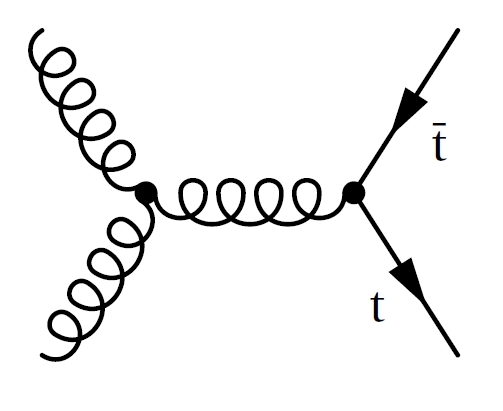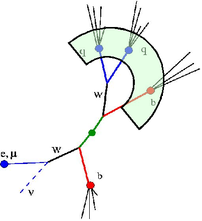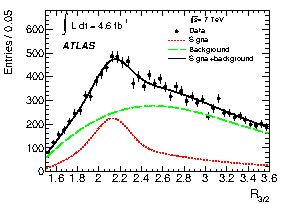Top quark
The top quark, which is roughly as heavy as a gold atom, is the heaviest known elementary particle. Being the weak isospin partner of the bottom quark, its existance was predicted in the late 1970ies. The experimental discovery was only 1995 at the Tevatron accelerator at the Fermilab due to the high mass. Since 2010 top quarks are also produced in Europe at the LHC. Due to the higher center-of-mass energy of LHC the production cross section is about an order of magnitude larger than at the Tevatron. So, after only two years of LHC operation the statistical precision of top-quark measurements exceeds that of the Tevatron. Starting in 2015 the center-of-mass energy of LHC will first be raised to 13 TeV with another ramp-up to 14 TeV in 2016. This will increase the production cross section for top quark by roughly another order of magnitude so that LHC become a "top quark factory" which allows many precision studies and measurements on the properties of the top quark.

Some of the fundamental properties of the top quark have been measured at high precision, in particular its mass. Nevertheless, these properties remain a focus of current research because of the essential role of the top quark in the Standard Model. Its large mass results from a Yukawa coupling strength to the Higgs field of almost unity. Thus the top quark dominantly contributes to the quantum corrections of the Higgs particle which become important for any extrapolation of Standard Model to extremely high energies and which are related with some of the fundamental deficiencies of the Standard Model lilke the hierarchy problem and the stability of the electroweak vacuum state in the Higgs potential. If any bigger symmetry like Supersymmetry shall protect the mass of the Higgs particle against quantum corrections, this symmetry must have a particle with similiar Yukawa coupling strength to the Higgs field. So one must expect a new kind of particle of similar mass like top quark but with the statistical properties of a boson, for example the scalar top quark which is part of Supersymmetry.
Our current focus is on precision measurements of the top quark mass. We devise, test, and establish new methods for the measurement of the mass all of which shall be less prone to systematic uncertainties from the detector. By exploiting the W boson which appears as a product in every top-quark decay, the ratio R32 of top quark over the W-boson masses turned out to be less sensitive to the precision of the energy measurements in the detector. This observable was used by ATLAS for the first measurement of the top-quark mass. A doctoral research study of our group which considered only decays of the top quark via an intermediate W boson into quarks became published by ATLAS as a precision measurement of the top quark mass.


Besides the mass measurement we also investigate properties of the rare top-quark decay, like the first experimental measurement of the branching fraction of top quarks decaying into a strange quark plus a W boson. This branching fraction is as small as 0.2% but its direct measurement is important for probing the unitarity of the quark mixing matrix. With the large amount of top quarks produced at 13 and 14 TeV collisions in the LHC such rare processes become accessible for direct experimental measurements. Although the Standard Model give an unique expectation for the top-quarks properties, observing deviations from this expectation may indicate phenomena which are beyond the Standard Model. This can show the path to an extension of the Standard Model to resolve its fundamental problems.

